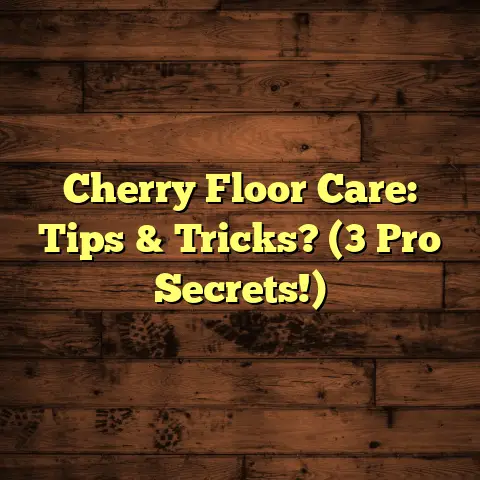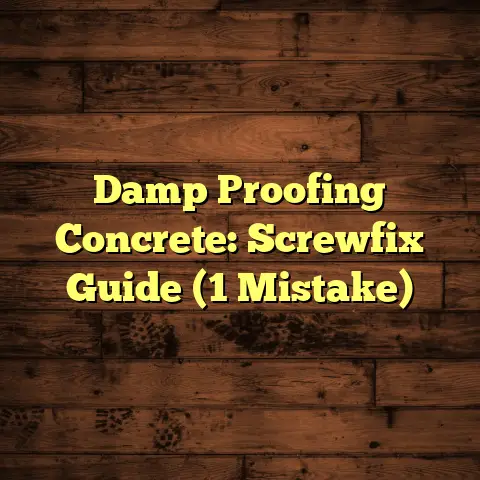How To Dry A Wet Floor? (911 Water Damage!)
Imagine your home is a ship, and water is pouring
in.
Panic sets in, right?
That’s exactly how I see
a wet floor – a potential disaster demanding
immediate action.
Ignoring it?
You’re setting the stage for mold
growth, structural nightmares, and even health
problems.
Trust me, I’ve seen it all in my years
as a flooring contractor.
Let’s dive into how
to handle this 911 situation!
Section 1: Understanding Water Damage
So, what exactly is water damage?
It’s any
harm done to your floor (and potentially beyond)
by excessive moisture.
Think floods, leaky pipes,
a washing machine gone wild – you name it, I’ve
probably dealt with it.
Now, different floors react differently.
* Hardwood: Prone to warping and cupping.
* Laminate: Can bubble and delaminate.
* Carpet: A breeding ground for mold.
* Tile: Grout can absorb and retain moisture.
Beyond the obvious wetness, keep an eye out for these telltale signs:
- Discoloration
- Warping or buckling
- A musty, unpleasant odor
These are all red flags screaming, “Water damage is here!”
Section 2: Immediate Response to Water Damage
Okay, you’ve spotted the problem. What now? First, SAFETY FIRST!
- Electrical Hazards: Before you do anything,
make sure there’s no risk of electrocution.
Turn off the power to the affected area if necessary. - Stop the Source: Find the leak or source
of the water and shut it off immediately.
Every second counts.
Next, documentation is key, especially for insurance claims.
- Photos & Videos: Take pictures and videos of the damage from every angle.
- Keep Records: Save all communication with insurance companies, plumbers, and restoration services.
This evidence will be invaluable when filing your claim.
Section 3: Initial Water Removal Techniques
Alright, let’s get that water out!
Here are my
go-to methods for the initial attack:
Using a Wet/Dry Vacuum
This is your best friend in a water emergency.
- Settings: Use the “wet” setting.
- Attachments: Use a wide floor nozzle.
- Technique: Overlap your passes to ensure you’re picking up as much water as possible.
- Empty Often: Don’t let the vacuum get too full, or it will lose suction.
I’ve seen homeowners suck up gallons and gallons with these things. It’s impressive!
Mopping and Toweling
Simple, but effective, especially for smaller spills.
- Mop Choice: Microfiber mops are super absorbent.
- Towel Power: Use old towels you don’t mind sacrificing.
- Wring & Repeat: Wring out the mop or towel frequently and keep going until you’ve soaked up as much water as possible.
Sumps and Pumps
For serious flooding, you might need the big guns.
- Sump Pump: If you have a basement, you
probably already have one.
Make sure it’s working! - Submersible Pump: These can be placed directly in standing water to pump it out.
Installation Tip: Always follow the manufacturer’s instructions carefully.
Section 4: Drying Techniques for Different Floor Types
Now for the tricky part – drying!
Each floor type
requires a slightly different approach.
Hardwood Floors
These are the divas of the flooring world.
They
warp and cup easily if you’re not careful.
- Fans: Place fans to circulate air across the floor.
- Dehumidifier: This will pull moisture out of the air.
- Air Circulation: Open windows (if the humidity outside is lower than inside) or use an air conditioner.
- Patience: This can take days, even weeks.
Pro Tip: Consider renting commercial-grade drying equipment for faster results.
Carpet and Pad
Carpet is a sponge. The pad underneath? Even worse.
- Lift the Carpet: If possible, lift the
carpet to allow air to circulate underneath.
You might need to cut it along the edges.
Don’t be afraid to call a professional for this. - Dry Thoroughly: Use fans and a dehumidifier to dry both the carpet and the pad.
- Consider Replacement: If the carpet or pad is heavily soiled or has been wet for more than 24-48 hours, it’s probably best to replace it.
Mold growth in carpet is a serious health hazard. Don’t take chances!
Tile and Grout
Tile itself is waterproof, but the grout isn’t.
- Dry the Surface: Wipe up any standing water on the tile surface.
- Focus on Grout: Use fans and a dehumidifier to dry the grout lines.
- Grout Sealer: Once the grout is completely dry, apply a grout sealer to help prevent future moisture absorption.
I’ve seen grout become a breeding ground for mold even after the tile seems dry.
Section 5: The Role of Dehumidifiers and Fans
These two are your dynamic duo in the fight against moisture.
- Dehumidifiers: They pull moisture from the air, creating a drier environment that helps floors dry faster.
Best Practices:
- Placement: Place the dehumidifier in the center of the affected area.
- Settings: Set it to the lowest humidity level possible.
-
Empty Regularly: Empty the water collection tank frequently.
-
Fans: They circulate air, which helps speed up the evaporation process.
Best Practices:
- Placement: Position fans to blow air across the wet floor.
- Airflow Management: Open windows (if the humidity outside is lower) to create cross- ventilation.
Ideal Humidity Levels: Aim for a humidity level
below 50%.
You can use a hygrometer to monitor
the humidity.
Section 6: Monitoring and Prevention of Future Water Damage
Even after you think you’ve dried everything, keep a close watch.
- Check for Moisture: Use a moisture meter to check for hidden moisture in walls, under baseboards, and in other hard-to-reach areas.
- Sniff Test: Trust your nose. If you smell mustiness, there’s still moisture present.
Prevention is Key!
- Regular Maintenance: Check your plumbing regularly for leaks.
- Water Alarms: Install water alarms near potential leak sources.
- Moisture Barriers: Use moisture barriers under flooring, especially in basements.
Section 7: When to Call Professionals
Sometimes, DIY just isn’t enough. Here’s when you need to call in the pros:
- Significant Flooding: If you have several inches of standing water, call a professional.
- Extensive Damage: If the water damage has spread to walls, ceilings, or other areas, it’s time for professional help.
- Persistent Moisture: If you can’t seem to get the floor completely dry, even after several days of drying, there may be hidden moisture.
Benefits of Hiring Professionals:
- Specialized Equipment: They have powerful drying equipment that can dry floors much faster than DIY methods.
- Expert Knowledge: They know how to identify and address hidden moisture problems.
- Peace of Mind: Knowing that the job is being done right can give you peace of mind.
What to Expect:
- Inspection: They’ll start with a thorough inspection of the damage.
- Water Extraction: They’ll use specialized equipment to remove any standing water.
- Drying: They’ll use fans and dehumidifiers to dry the affected areas.
- Mold Remediation: If mold is present, they’ll take steps to remove it.
Conclusion
Drying a wet floor is a race against time.
The
sooner you act, the better your chances of
preventing serious damage.
Remember, it’s not
just about getting rid of the water; it’s about
preventing mold growth, structural damage, and
health hazards.
By taking the right steps and, when necessary,
calling in the pros, you can protect your home
and your health.
And that peace of mind?
Priceless.





